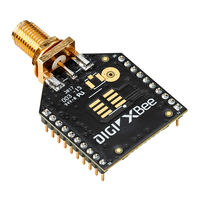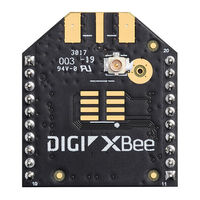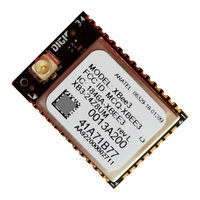
Digi XBee3 DigiMesh 2.4 Manuals
Manuals and User Guides for Digi XBee3 DigiMesh 2.4. We have 5 Digi XBee3 DigiMesh 2.4 manuals available for free PDF download: User Manual, Hardware Reference Manual, Update Instruction Manual
Digi XBee3 DigiMesh 2.4 User Manual (235 pages)
RF Module
Brand: Digi
|
Category: Control Unit
|
Size: 9 MB
Table of Contents
-
Get Started
16 -
-
File System
49-
Paths50
-
Limitations50
-
-
Modes
57 -
I/Osupport
71-
-
Source76
-
Destination77
-
-
Networking
81-
-
-
MAC Layer85
-
-
Encryption86
-
-
-
Sleep Modes98
-
Sleep Parameters100
-
Sleep Pins100
-
Sleep Conditions101
-
The Sleep Timer101
-
Diagnostics110
-
-
Atcommands
112-
-
ID (Network ID)112
-
-
SM (Sleep Mode)127
-
SP (Sleep Time)128
-
ST (Wake Time)128
-
-
-
BD (Baud Rate)131
-
NB (Parity)132
-
SB (Stop Bits)132
-
AP (API Enable)133
-
AO (API Options)134
-
-
-
RP Command151
-
LT Command151
-
-
T0 (D0 Timeout)155
-
T8 (D8 Timeout)157
-
T9 (D9 Timeout)157
-
Q0 (P0 Timeout)157
-
Q1 (P1 Timeout)158
-
Q2 (P2 Timeout)158
-
-
WR (Write)161
-
-
-
-
-
OTA/OTB File205
-
Fs.ota File205
-
The OTA Header205
-
-
Storage207
-
Image Notify208
-
-
Advertisement
Digi XBee3 DigiMesh 2.4 User Manual (172 pages)
Cellular LTE-M Smart Modem
Table of Contents
-
-
Hardware
56 -
Modes
70-
Command Mode74
-
Sleep Modes
77 -
File System
91-
-
Paths92
-
Secure Files92
-
-
-
TLS at Commands
100-
API Mode and TLS101
-
Key Formats101
-
Cipher Suites102
-
AT Commands103
-
Special Commands104
-
FR (Force Reset)104
-
WR (Write)104
-
-
S# (ICCID)105
-
IM (Imei)105
-
MN (Operator)105
-
Network Commands107
-
-
N1 (DNS Address)111
-
N2 (DNS Address)112
-
C0 (Source Port)113
-
-
BD (Baud Rate)113
-
NB (Parity)114
-
SB (Stop Bits)114
-
AP (API Enable)115
-
-
-
D0 (Dio0/Ad0)116
-
D1 (Dio1/Ad1)116
-
D2 (Dio2/Ad2)117
-
D3 (Dio3/Ad3)117
-
D4 (Dio4)118
-
D6 (Dio6/Rts)118
-
D7 (Dio7/Cts)119
-
P3 (Dio13/Dout)122
-
P4 (Dio14/Din)122
-
-
-
TP (Temperature)124
-
-
Sleep Commands125
-
-
R (Modem Reset)133
-
-
Error Responses134
-
Atfs Pwd134
-
Atfs Info136
-
-
API Frames
143 -
-
Troubleshooting
160-
Brownout Issue165
-
Socket Leaks166
Digi XBee3 DigiMesh 2.4 Hardware Reference Manual (45 pages)
RF Module
Brand: Digi
|
Category: Control Unit
|
Size: 0 MB
Table of Contents
-
Hardware
11-
Design Notes21
-
-
Europe (CE)35
-
-
For Xbee337
-
RF Exposure38
Advertisement
Digi XBee3 DigiMesh 2.4 User Manual (15 pages)
Table of Contents
-
Safety2
-
-
FCC Notices14
-
ISED Notices14
-
Europe (CE)14
-
Digi XBee3 DigiMesh 2.4 Update Instruction Manual (6 pages)
Cellular LTE-M Cellular Module Patch.
Brand: Digi
|
Category: Control Unit
|
Size: 2 MB
Table of Contents
Advertisement




